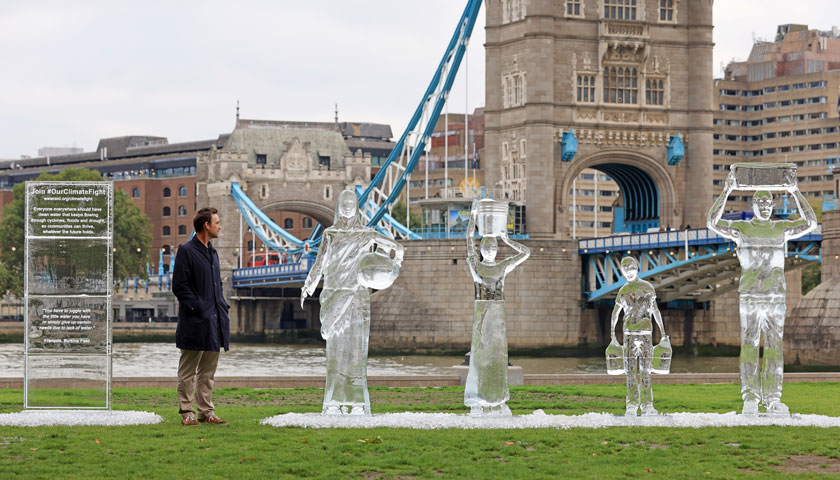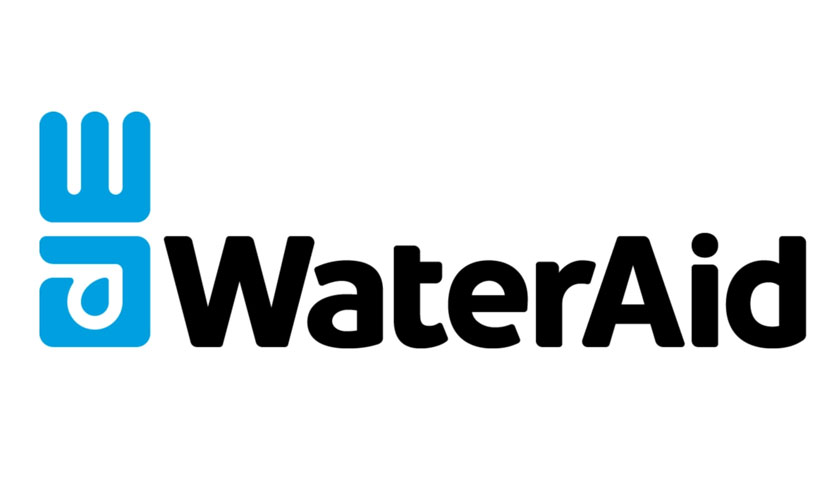WaterAid unveiled four striking ice sculptures featuring people from around the world collecting water, to highlight how climate change is causing fragile water sources to disappear for vulnerable communities.
The international organisation created the ice figures on the banks of the Thames to share the realities of those living on the frontlines of climate change as part of its campaign, Our Climate Fight, ahead of the UN General Assembly this month and COP26, the UN’s global climate conference this November.
Actor Dougray Scott is supporting the campaign and joined WaterAid in London to encourage the public to add their name to its open letter urging the UK Government to help vulnerable communities get a reliable source of water, so they can protect themselves from the destructive effects of climate change.
The sculptures are based on people from Mali, Burkina Faso, India and Colombia who are among the one in ten globally with no clean water close to home, leaving them more susceptible to disease and having a damaging impact on education and livelihoods.
Climate change is making it even harder for many to get clean water. Longer droughts dry up springs and wells, and more frequent flooding pollutes poorly protected water supplies. By 2040, climate change could make water perilously scarce for 1 in 4 children. A reliable source of clean water that keeps flowing whatever the weather helps people living on the frontlines of climate change to adapt and build a better future.
WaterAid worked with London-based ice artists, The Icebox, to create the beautiful ice sculptures, that draw attention to the need to help people adapt to the climate emergency. As the ice began to melt, it highlighted the fragility of water and the consequences of global complacency.
François, a farmer and father-of-three from Burkina Faso, was one of the people whose story was brought to life through the ice. The boreholes and wells in his village have started drying up because of rising temperatures.
François, 31, said:
“You have to juggle with the little water you have or simply give up certain needs due to lack of water.”
François’ story features in the charity’s open letter, which was written by WaterAid’s Basile Ouedraogo from Burkina Faso and is nearing 10,000 signatures from celebrities, leading cross-party politicians and members of the public*. The letter will be presented to Boris Johnson and Dominic Raab ahead of COP26 urging them to invest a third of the UK’s committed international climate funding in locally-led adaptation projects, to help vulnerable communities get a reliable source of water, so they can protect themselves against the impacts of climate change.
Actor and WaterAid Ambassador Dougray Scott (Ripley’s Game, Enigma, My Week with Marilyn, Mission Impossible II, The Women in White) signed an ice wall in London’s Potter’s Fields as a visual commitment to the climate fight. He said:
“WaterAid’s ice sculptures highlight the fragility of water and the threat posed by climate change. Each beautiful ice figure represents someone who doesn’t have clean water close to home and who faces an uncertain future as extreme weather will make it even harder for them to access this basic human right.
“Everyone should have a reliable supply of water that keeps flowing through flood, drought and natural disasters. I saw the difference it makes to people’s lives while visiting Mozambique with WaterAid; families are healthier, children have more time for school and their parents can earn a living. I’m supporting Our Climate Fight to help get clean water to people living in poverty so they can better withstand the impacts of climate change. Please join us and help communities stay safe and healthy, whatever tomorrow brings.”
Only 5% of total global climate funding is spent helping countries adapt to the climate emergency, and much of that money is not invested in the communities most impacted by climate change.i Some of the most climate-vulnerable countries receive only $1 per person per year for water yet protecting water and sanitation services from extreme weather is highly cost-effective. For every $1 spent upgrading flood-resistant infrastructure, $62 is saved in flood restoration costs.ii
Tim Wainwright, Chief Executive for WaterAid, said:
“The climate crisis is a water crisis, and across the world, millions of families who struggle to access essentials like clean water face an increasingly uncertain future because of climate change.
“For COP26 to be a success, the Prime Minister must lead rich nations in ensuring more finance goes to help the world’s poorest climate-vulnerable communities. If everyone everywhere has a reliable supply of clean water, they can adapt and build resilience to extreme weather so they can stay healthy and thrive, whatever tomorrow brings.”
Sign WaterAid’s open letter: www.wateraid.org/climatefight

